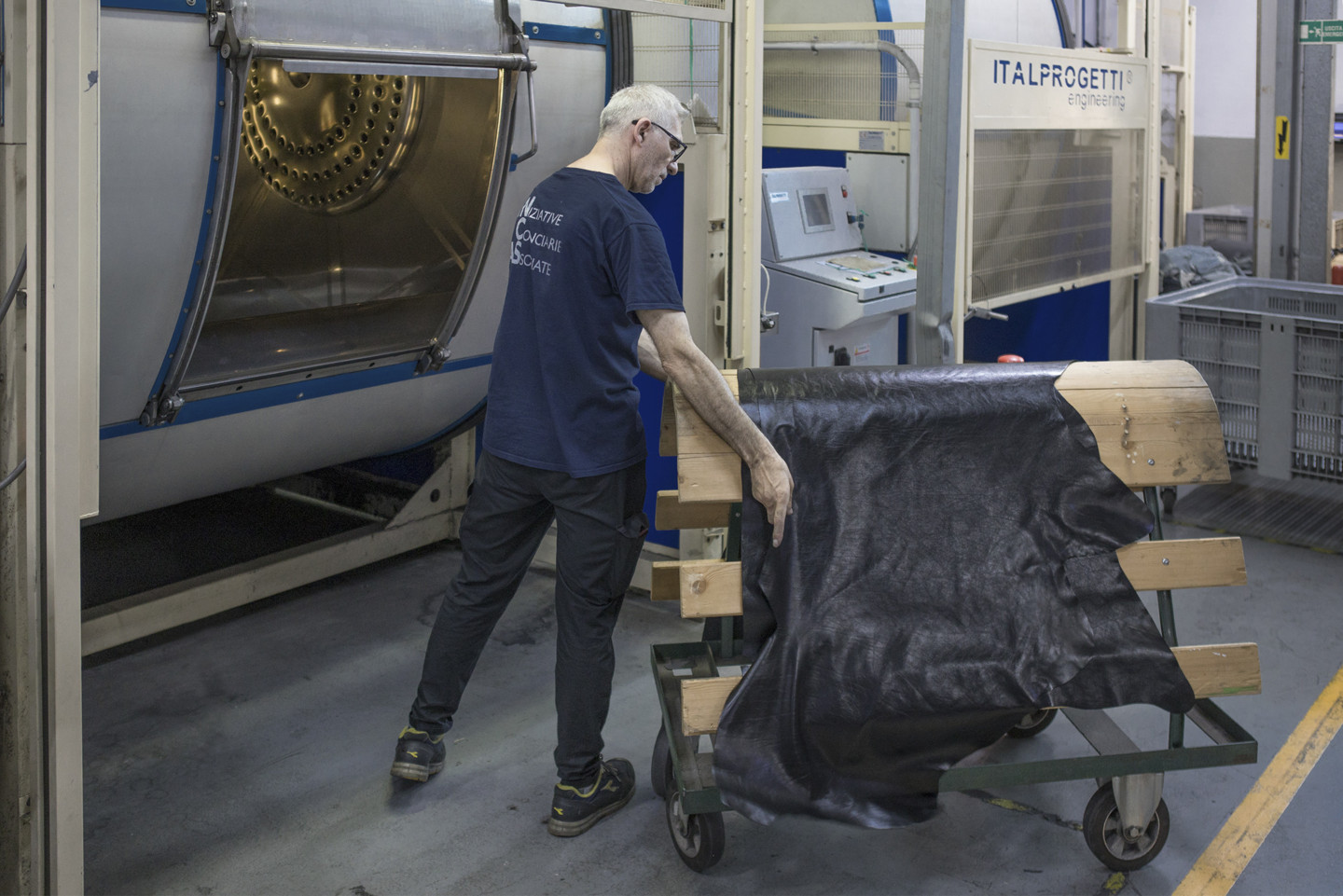
Huntsman: new SCF technology for sports and lifestyle footwear
One of the leading suppliers of PU solutions for footwear manufacturers, Huntsman presented its new SMARTLITE® SCF 280 TPU at SIMAC.
Keep reading...
From research on modified natural tannins to a replicable industrial model: results, environmental impacts and prospects of the European project for an innovative solution to make eco-conscious leather. A project coordinated by Silvateam.
June 2025

The LIFE I’M TAN project draws to a close. Launched in September 2021 and funded by the European Union under the LIFE programme (LIFE20 ENV/IT/000759), the initiative set out to enhance traditional vegetable tanning and retanning processes through the development of a new generation of high-performance natural tannins. These innovative extracts undergo innovative purification and chemical-physical modification processes. Production is currently at the pilot stage, with market analysis, feasibility studies and cost assessments underway to support the scale-up to full industrial manufacturing.
The project was carried out by five Italian companies, all directly or indirectly connected to the leather tanning industry and was coordinated by Silvateam. These partners are Crossing, Centro Ricerca per la Chimica Fine (CRCF), Incas tannery and the Aquarno Consortium.
PROJECT GOALS AND CONCEPT
The primary objective of the LIFE I’M TAN project was to develop and validate a new generation of innovative, purified and chemically modified natural tannins. These advanced tannins are designed not only to enhance existing vegetable tanning processes but also to enable entirely new, more sustainable solutions. Central to the project is a strong commitment to environmental, economic and social sustainability, as well as a forward-looking vision, aligning with forthcoming EU regulations such as the Digital Product Passport and the Regulation on Deforestation-Free Products.
Over the course of four years of research and applied development, the project successfully designed a new class of natural tannins derived from botanical sources such as chestnut and quebracho wood. These groundbreaking tanning agents offer environmentally sustainable alternatives, contributing to a reduced reliance on hazardous chemicals, decreased water consumption and improved wastewater quality.
In parallel, the project assessed the feasibility of valorising by-products from the tannin production, as well as leather scraps and trimmings, by transforming them into high value-added solutions, demonstrating a practical and scalable model of circular economy.
The entire research and development process was carried out following a rigorous analytical methodology based on specific Key Performance Indicators (KPIs), including Life Cycle Assessment (LCA) of the leather and technical evaluations aligned with the standards set by the leather tanning industry and the extremely demanding automotive and fashion brands.
ACTIONS AND KEY RESULTS
The LIFE I’M TAN project was structured around several core activities:
– Benchmarking and environmental analysis: A thorough evaluation of conventional tanning technologies currently used in the market was conducted to establish baseline environmental impact indicators. This benchmarking served as a critical reference point, enabling the quantification of improvements achieved through the application of the newly developed modified tannins.
– Development of purified and enhanced natural tannins: Led by a dedicated green chemistry team from Silvateam, Crossing and CRCF, the project designed advanced processes for the purification and chemical modification of natural tannins. The resulting extracts demonstrated significantly improved chemical and physical characteristics compared to conventional benchmarks. Several of these new tannins deliver enhanced performance while requiring lower application dosages, thanks to their higher concentration of active ingredients. Others, distinguished by a notably lighter colour than standard tannins, possess optimal chemical properties for stabilising hides during the pickle phase, contributing to a reduction in the use of fossil-derived compounds in the pre-tanning process.
– Application in leather production: The innovative tannins were subjected to extensive application testing in both laboratory and industrial environments. Conceria Incas carried out full-scale production runs of leather intended for footwear and leather goods, successfully demonstrating the practical applicability and enhanced performance of the new tanning agents. Leathers treated with the LIFE I’M TAN extracts exhibited excellent versatility in colour development, including the ability to achieve light and pastel shades, representing a significant improvement in comparison with conventional tannins. In addition, preliminary results suggest strong potential for these tannins in the formulation of waterproof leathers, an area identified for further exploration and development.
– Environmental footprint of the new tanning process: The benchmark comparison was extended to include also a comprehensive analysis of environmental impact indicators. The Aquarno Consortium, in collaboration with Conceria Incas and CRCF, conducted in depth evaluations of key chemical and physical parameters, focusing on optimising wastewater treatment processes and delivering measurable environmental improvements:
o Water consumption during the tanning phases was reduced by 5% to 25%, depending on the type of leather article produced. This optimisation was due to the high efficiency and adaptability of the newly developed modified tannins, which support the creation of leather products that meet or exceed industry performance benchmarks.
o Tanning bath analyses showed a reduction of up to 40% in organic matter content, measured as Chemical Oxygen Demand (COD), when compared to conventional reference processes.
o Also potentially hazardous substances, including phenol, bisphenols and formaldehyde, were reduced by more than 80%, a direct result of significantly lowering the use of synthetic tanning agents in the process.
o Biodegradability testing of treated wastewater is currently underway to determine whether the reduced pollutant load is also accompanied by enhanced biodegradability. These evaluations will be finalised upon project completion.
All environmental impact data collected contributes directly to the project’s Life Cycle Assessment (LCA) and Life Cycle Costing (LCC) studies, ensuring a holistic understanding of both the sustainability and economic viability of the new tanning process.
– Upcycling of LIFE I’M TAN by-products: An additional key benefit of the new natural tannins is the significant reduction in production waste, both from the chemical processing and leather tanning phases. The advanced purification processes developed for the modified tannins enabled the recovery and upcycling of certain by-products into high-value ingredients for use in other sectors, including animal nutrition and the manufacture of environmentally friendly resins. In parallel, leather scraps and trimmings generated during manufacturing can be recycled through a hydrolysis process into fertilisers suitable for organic agriculture. This approach contributes to closing the loop on material reuse and supports a fully circular model for leather valorisation.
SUSTAINABILITY AND FUTURE OUTLOOK
The results achieved thus far, while pending broader validation at full industrial scale, clearly demonstrate that the new modified natural tannins offer a promising pathway toward a next-generation tanning technology that is innovative, environmentally sustainable and commercially viable.
From an economic standpoint, vegetable tanning and retanning processes based on these advanced tannins enable a more efficient use of raw materials by reducing the need for conventional tanning agents. At the same time, they support the production of high performance, soft leathers available in a broad spectrum of colours, adopting simplified bio-based formulations.
As the LIFE I’M TAN project concludes, attention now turns to scaling and disseminating these innovations across the leather tanning sector. The project provides a replicable, industrially relevant model for sustainable tanning practices, with strong potential for adoption across Italy and the wider European market. By embracing these modified natural tannins, the leather industry can significantly improve its environmental footprint, elevate product quality and align more closely with emerging regulatory frameworks. Importantly, these tannins exhibit strong transferability beyond leather processing, with potential applications in fields such as animal nutrition and the development of sustainable resins and polymers.
LIFE I’M TAN has demonstrated that collaborative innovation and a clear sustainability focus can modernise traditional industries, delivering meaningful environmental, economic and social impact across the value chain.

One of the leading suppliers of PU solutions for footwear manufacturers, Huntsman presented its new SMARTLITE® SCF 280 TPU at SIMAC.
Keep reading...
At SIMAC Tanning Tech 2025, the Group presented new materials, concepts and recycling methods for PU in the footwear industry.
Keep reading...
When the work of the mould maker becomes a training tool for new generations of footwear designers.
Keep reading...You must login to read this free content
This content requires a subscription to view. Are you already a subscriber? Sign in